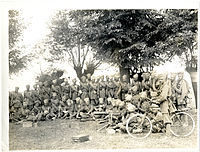6th Jat Light Infantry
| 6th Jat Light Infantry | |
|---|---|
 | |
| Active | 1803-1922 |
| Country | |
| Branch | Army |
| Type | Infantry |
| Part of | Bengal Army (to 1895), Bengal Command |
| Uniform | Red; faced pea-green, 1887 white |
| Engagements | Nagpore 1838 - 42 Afghanistan Kandahar Ghuznee 1842 Cabul Maharapore Sobraon 1878 - 80 Afghanistan 1878 Ali Masjid 1900 China |
| Commanders | |
| Colonel-in-Chief | King Edward VII (1904) |
The 6th Jat Light Infantry were an infantry regiment of the Bengal Army, later of the united British Indian Army. They could trace their origins to 1803, when they were the 1st Battalion, 22nd Bengal Native Infantry. Over the years they were known by a number of different names the 43rd Bengal Native Infantry 1824–1842, the 43rd Bengal Native (Light) Infantry 1842–1861, the 6th Bengal Native (Light) Infantry 1861–1897 and finally after the Kitchener reforms of the Indian Army the 6th Jat Bengal (Light) Infantry. The regiment was involved in the First Anglo-Afghan War, the First Anglo-Sikh War, the Second Anglo-Afghan War, the Boxer Rebellion and World War I. After World War I the Indian Government reformed the army moving from single battalion regiments to multi battalion regiments.[1] The 6th Jat Light Infantry became the new 1st Battalion, 9th Jat Regiment. After India gained independence they were one of the regiments allocated to the Indian Army.[2]
References
- ^ Sumner, p.15
- ^ "Armed Forces: Units: Indian Infantry: 6th Jat Light Infantry". British Empire. Retrieved 2014-02-15.
- Sumner, Ian (2001). The Indian Army 1914-1947. Osprey Publishing. ISBN 1-84176-196-6.
- British Indian Army infantry regiments
- British colonial regiments
- Honourable East India Company regiments
- Military units and formations established in 1803
- Military units and formations of the Boxer Rebellion
- Military units and formations disestablished in 1922
- Bengal Presidency
- 1803 establishments in the British Empire
- Indian military stubs
